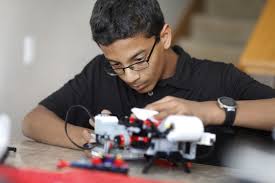Santa Clara, US: In Silicon Valley, it’s never too early to become an entrepreneur. Just ask Indian-origin 13-year-old Shubham Banerjee.
The California eighth-grader has launched a company to develop low-cost machines to print Braille, the tactile writing system for the visually impaired. Tech giant Intel Corp. recently invested in his startup, Braigo Labs.
Shubham built a Braille printer with a Lego robotics kit as a school science fair project last year after he asked his parents a simple question: How do blind people read? “Google it,” they told him.
Shubham then did some online research and was shocked to learn that Braille printers, also called embossers, cost at least $2,000 too expensive for most blind readers, especially in developing countries.
“I just thought that price should not be there. I know that there is a simpler way to do this,” said Shubham, who demonstrated how his printer works at the kitchen table where he spent many late nights building it with a Lego Mindstorms EV3 kit.
Shubham wants to develop a desktop Braille printer that costs around $350 and weighs just a few pounds, compared with current models that can weigh more than nine kilograms. The machine could be used to print Braille reading materials on paper, using raised dots instead of ink, from a personal computer or electronic device.
“My end goal would probably be having most of the blind people … using my Braille printer,” said Shubham, who lives in the Silicon Valley suburb of Santa Clara, just minutes away from Intel headquarters.
After the “Braigo” a name that combines Braille and Lego won numerous awards and enthusiastic support from the blind community, Banerjee started Braigo Labs last summer with an initial $35,000 investment from his dad.
“We as parents started to get involved more, thinking that he’s on to something and this innovation process has to continue,” said his father, Niloy Banerjee, an engineer who works for Intel.
Shubham used the money to build a more sophisticated version of his Lego-based printer using an off-the-shelf desktop printer and a newly released Intel computer chip. The new model, Braigo 2.0, can translate electronic text into Braille before printing. Intel executives were so impressed with Shubham’s printer that in November they invested an undisclosed sum in his startup.
Intel officials believe he’s the youngest entrepreneur to receive venture capital, money invested in exchange for a financial stake in the company.








